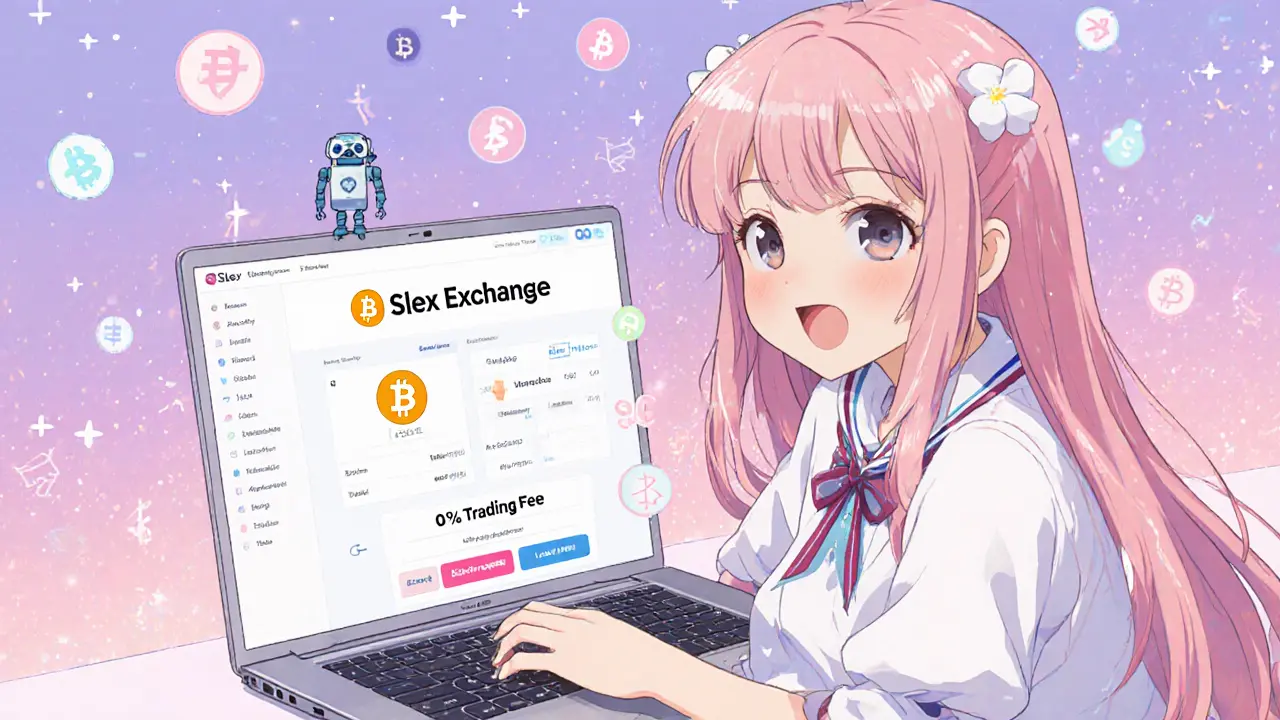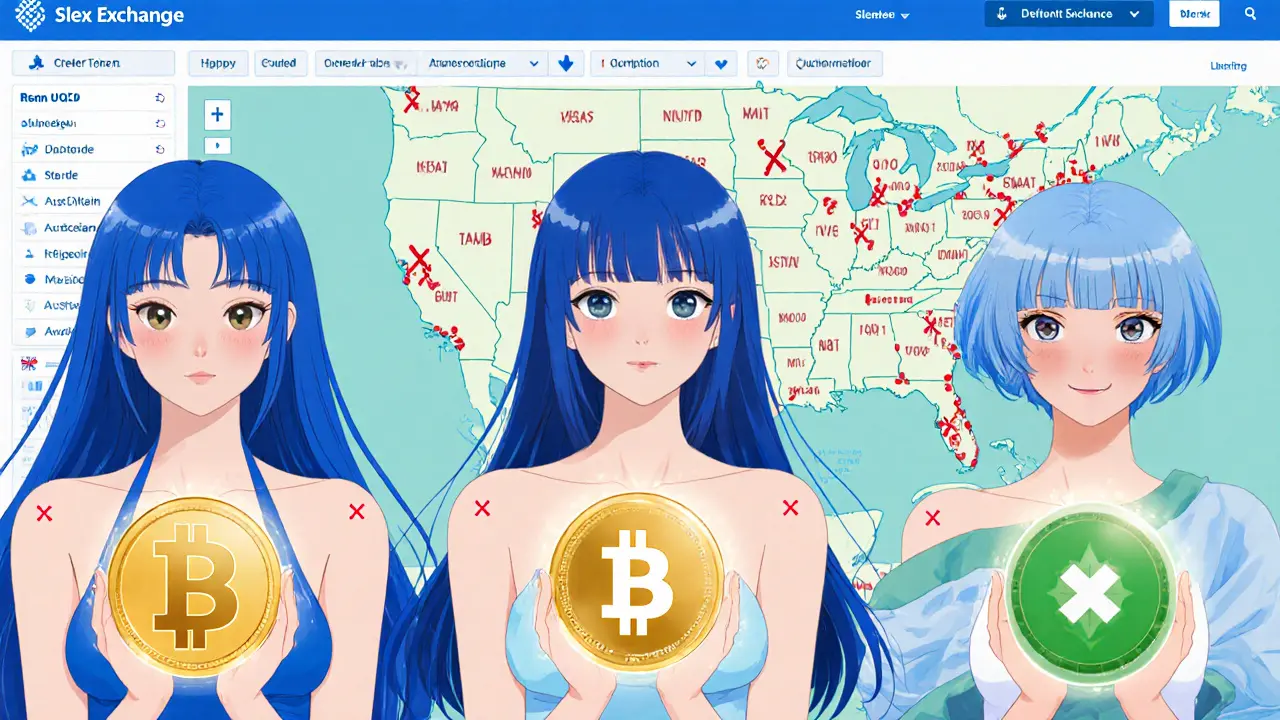Slex Exchange Review: Is the Zero‑Fee Crypto Exchange Worth Your Money?

Slex Exchange Fee Calculator
Slex Exchange Fee Breakdown
When evaluating crypto platforms, Slex Exchange is a centralized exchange launched in August 2023 that markets itself as a hybrid ecosystem of spot trading, tokenized commodities and AI‑driven tools.
- Zero‑fee spot trading (maker & taker)
- Supports >100 crypto pairs and tokenized commodities
- Unregulated, limited leverage, and jurisdiction blocks
- Native deflationary SLEX token with buy‑back‑and‑burn
- Mobile access via browser, no dedicated app
What Slex Exchange Offers
The platform’s headline claim is "zero‑fee trading," meaning you won’t see the usual 0.1 % - 0.2 % maker/taker charges you get on Binance or Coinbase. In practice, Slex applies a 0 % rate to all spot trades, which can shave a few dollars off high‑volume day‑trading strategies.
Beyond standard spot pairs like Bitcoin (BTC) and Ethereum (ETH), the exchange lists a handful of tokenized commodities - gold‑backed stablecoins, copper tokens and even a carbon‑credit asset tied to mining operations in the Democratic Republic of Congo. The idea is to let traders diversify without leaving the exchange.
AI trading bots are baked into the dashboard. You can pick from pre‑built strategies (trend‑following, mean‑reversion, arbitrage) or upload your own algorithm via the API. The API is REST‑based, works 24/7, and supports standard order types (limit, market).
Fee Structure & Cost Comparison
Slex Exchange review centers on its cost advantage. While Binance charges 0.1 % maker and 0.1 % taker for most pairs, and Coinbase can levy up to 4 % for small retail trades, Slex simply lists 0 % on both sides.
That said, there are hidden costs to watch:
- Withdrawal fees vary by blockchain; Bitcoin withdrawals cost around 0.0005 BTC.
- Deposit via credit/debit cards carries a 2 % processing fee.
- The platform keeps a 10 % insurance fund from any fees it does collect (e.g., card deposits).
For high‑frequency traders, the fee savings can be sizable, but the extra fees on fiat on‑ramp and withdrawals may offset the benefit for occasional users.
Security, Custody & Insurance
Slex claims its trading engine runs on a distributed ledger and stores the bulk of assets in cold wallets. An insurance fund-equivalent to 10 % of all fees-acts as a safety net against hacks or operational failures.
Because the exchange is unregulated, there is no third‑party audit or licensing body guaranteeing those claims. Independent security audits have not been publicly released, which is a red flag for risk‑averse investors.

Pros and Cons at a Glance
| Pros | Cons |
|---|---|
| Zero‑fee spot trading reduces cost for active traders | Unregulated - no consumer protection |
| Over 100 crypto pairs plus tokenized commodities | No margin or futures yet (planned for future) |
| AI bot marketplace for automated strategies | Limited jurisdiction coverage - blocked in US, EU, UK, AU, etc. |
| VIP tier system offers lower withdrawal fees for high volume | Scam warnings on community watchdog sites |
| Insurance fund earmarked for emergency scenarios | No dedicated mobile app - must use browser |
Head‑to‑Head: Slex vs. Major Competitors
| Feature | Slex Exchange | Binance | Coinbase |
|---|---|---|---|
| Spot trading fees | 0 % | 0.1 % maker / 0.1 % taker | 0 % - 4 % (varies by volume) |
| Regulation status | Unregulated | Registered in Cayman, complies with AML/KYC | US‑registered, SEC‑compliant |
| Asset count | 100+ crypto + tokenized commodities | ≈ 1,300 pairs | ≈ 750 pairs |
| Leverage options | None (spot only) | Up to 125× | Up to 5× |
| Jurisdiction blocks | US, UK, CA, AU, EU, JP, SG, IL | Limited (US access via Binance.US) | Global (except restricted regions) |

User Experience, Support & Onboarding
Signing up is a three‑step process: email verification, KYC selfie upload, and a brief questionnaire about trading experience. Because the exchange is barred from many regions, residents of the United States, United Kingdom, Canada, Australia, Israel, Singapore, Japan and most EU countries receive a “service unavailable” message.
Deposits can be made via SWIFT/SEPA, crypto transfers, or fiat cards (Apple Pay, Google Pay). The minimum deposit is $5 USDT, which is low enough for newcomers to test the platform without a big commitment.
Customer support operates through email and a Telegram channel. Response times average 4‑6 hours on weekdays, but the knowledge base is thin - many users report having to rely on community forums for troubleshooting.
Regulatory Landscape & Red Flags
The biggest headache is the lack of regulatory oversight. No licence from a financial authority means the exchange can change terms with little notice, and users have limited recourse if funds disappear.
CryptoLinks.com listed Slex on its scam‑watch list, citing hidden team details and missing whitepaper. While the platform does publish a brief FAQ, it does not disclose founders, office locations, or audited financial statements.
Investors should treat Slex as a high‑risk, high‑reward playground. If you can afford to lose the capital you allocate, the zero‑fee edge might be attractive for short‑term scalping. If you need insurance and legal protection, a regulated exchange is safer.
Final Verdict: Should You Try Slex Exchange?
In short, Slex Exchange shines for traders who crave zero‑fee spot markets, want exposure to tokenized commodities, and enjoy tinkering with AI bots. The platform’s unregulated status, jurisdiction blocks, and community‑raised scam concerns are serious drawbacks.
If you’re based in a supported country, have a solid risk management plan, and are comfortable staying in the crypto‑only space (no fiat withdrawals to your bank), giving Slex a trial run with a small amount could be worthwhile. Otherwise, sticking with a regulated heavyweight like Binance or Coinbase is the safer bet.
Is Slex Exchange really free to trade?
Yes, Slex advertises 0 % maker and taker fees for spot trading. However, you still pay blockchain withdrawal fees and a 2 % fee for card deposits.
Can I trade futures or margin on Slex?
Not yet. The roadmap mentions futures in the next year, but today the platform only supports spot trading.
Is my money safe on an unregulated exchange?
Safety is harder to guarantee without regulatory oversight. Slex stores most assets in cold wallets and has an insurance fund, but there is no external audit. Treat funds on the platform as you would on any high‑risk service.
Which countries are blocked from using Slex?
The exchange blocks the United States, United Kingdom, Canada, Australia, Israel, Singapore, Japan and most European Union members.
How does the SLEX token work?
SLEX is a deflationary utility token used for fee rebates, staking rewards, and buy‑back‑and‑burn cycles. Holding SLEX can lower withdrawal fees and grant access to VIP tiers.
Brody Dixon
Hey, I get why the zero‑fee claim grabs attention. For traders who dabble a lot, shaving those maker/taker cents adds up. Just keep an eye on the 2 % card‑deposit fee and withdrawal charges – they can eat your profit fast. If you’re comfortable with the unregulated vibe, start small and test the AI bots before scaling.
Mike Kimberly
In evaluating Slex Exchange, one must first acknowledge the allure of its advertised zero‑fee spot trading, which superficially promises cost‑free transactions for all market participants. However, the absence of explicit fees on the surface belies a suite of ancillary charges, including blockchain withdrawal fees and a 2 % surcharge on card‑based fiat deposits, which collectively reintroduce the very expense the platform claims to eliminate. The exchange’s catalog of over one hundred cryptocurrency pairs, augmented by tokenized commodities such as gold‑backed stablecoins and carbon‑credit assets, affords a degree of diversification that is comparatively rare among nascent platforms. Moreover, the integration of AI‑driven trading bots presents an innovative avenue for algorithmic strategies, allowing users to either select from pre‑configured models or upload custom code via a well‑documented REST API. Yet, the AI marketplace remains in its infancy, with limited transparency regarding the performance metrics and risk parameters of the offered bots, thereby necessitating rigorous due diligence on the part of the trader. Security considerations are further complicated by the exchange’s unregulated status; while Slex asserts that the majority of assets are stored in cold wallets and an insurance fund equivalent to ten percent of accrued fees is maintained, the lack of third‑party audits undermines confidence in these safeguards. The platform’s jurisdictional restrictions, which exclude users from major economies such as the United States, United Kingdom, Canada, Australia, and the European Union, constrain its potential user base and may signal underlying compliance concerns. Additionally, the reliance on a browser‑based interface, in the absence of a native mobile application, may detract from the user experience for those accustomed to on‑the‑go trading. From a cost‑comparison perspective, seasoned high‑frequency traders could indeed realize modest savings relative to Binance’s 0.1 % maker/taker fees, but the net benefit is often neutralized by the aforementioned deposit and withdrawal fees. The SLEX token, featuring a deflationary burn mechanism and utility for fee rebates and VIP tier access, introduces a token‑economic layer that may appeal to speculative investors, though its long‑term value proposition remains uncertain. In summation, Slex Exchange occupies a niche that caters to fee‑sensitive, technically inclined traders willing to accept elevated regulatory risk, while more risk‑averse participants might prudently gravitate toward established, regulated exchanges. Future roadmap disclosures hint at forthcoming futures contracts and margin products, which could broaden its offering but also introduce leverage‑related hazards. Prospective users should monitor community forums for updates on audit releases, as independent verification would greatly enhance credibility. Given the rapid evolution of the crypto regulatory landscape, compliance status may shift, potentially unlocking previously blocked regions. Ultimately, the decision to allocate capital to Slex hinges on one’s tolerance for unregulated exposure versus the appeal of zero‑fee trading.
angela sastre
If you’re just getting started, the low $5 minimum deposit is a nice entry point to test the platform without risking a lot. The AI bots can be fun, but treat them like a demo – don’t trust them blindly with big sums. Keep an eye on the card‑deposit fee; it’s a flat 2 % and can eat up any tiny profit you make. Since the exchange is blocked in many countries, double‑check that you’re actually able to use it from your location. And remember, storing most of your crypto in cold wallets is good, but you still want a personal hardware wallet for extra safety.
Patrick Rocillo
Zero‑fee sounds cool, but watch the hidden costs! 😅
Aniket Sable
Totally agree! Gonna start with a tiny amount and see how those AI bots play out – hope it’s smooth sailing. 🚀
Santosh harnaval
Watch those withdrawal fees; they can negate the zero‑fee advantage.
Nisha Sharmal
Oh great, another “free” service that’ll probably disappear once they need to cash in.
Peter Schwalm
For anyone weighing options, consider the lack of futures as a notable gap if you plan to trade with leverage. Spot‑only means you’ll miss out on margin opportunities that other exchanges provide. Also, the insurance fund is only a percentage of fees collected, which on a zero‑fee platform is relatively small. If you can tolerate the regulatory uncertainty, the tokenized commodities are an interesting add‑on.
Alex Horville
Regulators love to stifle innovation; if you’re not afraid of a little risk, Slex is worth a shot.